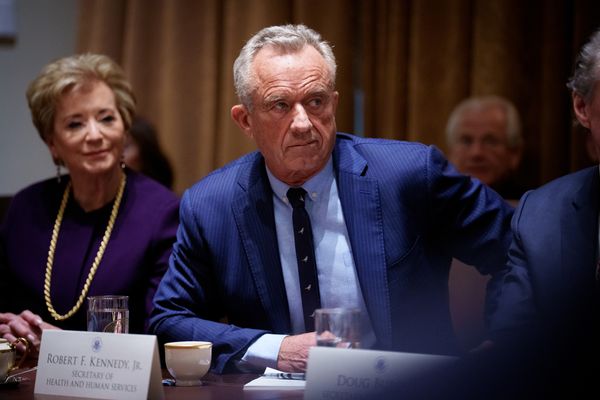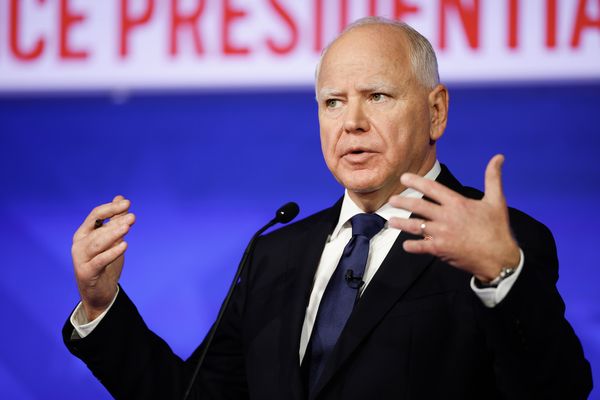/https://static.texastribune.org/media/files/585391514514755db0977e4cd67c2806/0128%20Dem%20Senate%20Primary%20MC%20TT%2016.jpg)
WASHINGTON — With more than four months left before Election Day 2018, Democrat Beto O’Rourke had campaigned in all of Texas’ 254 counties in his bid to unseat Republican U.S. Sen. Ted Cruz. It was a novel strategy central to breaking through in a Republican-controlled state that national Democrats had largely written off.
Six years later, U.S. Rep. Colin Allred is taking a much more traditional approach to campaigning as he tries to do what O’Rourke couldn’t: topple Cruz. Allred has made only 125 campaign stops so far, focusing instead on getting his message out early and directly to wide swaths of voters in TV, radio and digital ads. The Allred campaign isn’t skimping on the state’s expensive media markets, booking ads in the Houston, San Antonio, Laredo and Rio Grande Valley markets last month, and placing English and Spanish ads on digital platforms statewide.
Most notably, national Democrats are showing their confidence by investing in the state more proactively than in the past.
The change in tactic shows how the landscape in Texas has evolved for Democrats since the last time they tried to oust Cruz. Democrats outside of Texas have long thought the state is just too big, too expensive and too Republican to bother pouring in money. But the near-success of the 2018 O’Rourke campaign, the development of Democratic campaign infrastructure and the roster of U.S. Senate seats up for election this year are pushing the party to take Texas more seriously.
“In terms of Texas, we have a real opportunity there. Colin Allred is a strong candidate. He won decisively a primary. He is a man who was able to win a tough seat in the Dallas area, beating an entrenched Republican,” Sen. Gary Peters, who chairs the Democratic Senatorial Campaign Committee, said in a March interview with MSNBC’s Morning Joe. “He knows how to win.”
To be sure, Democrats will be running uphill in the state, which Republicans have dominated for a generation. Cruz has made it clear he is not taking anything for granted after the 2018 scare when O’Rourke came within 3 points of beating him. That year was the closest Democrats came to breaking their long-running statewide drought.
Cruz maintains strong support among conservative voters in Texas, often polling close to Gov. Greg Abbott for most popular statewide elected official among registered Republicans. Cruz is better armed this cycle, with almost double the amount of cash on hand now than at the same point in 2018.
Cruz is also a more seasoned candidate than he was during his last run. He has greater seniority in the Senate and a roster of legislative accomplishments he is eagerly touting — many of which he achieved with members of the other party. As the top Republican on the Senate Commerce Committee, he oversaw his GOP colleagues in passing aviation safety legislation, and he has worked with Democrats on issues ranging from sexual assault in the military to cross-border commerce. For the first time, he’s making his bipartisanship and less-celebrated work a core part of his campaign.
National Democrats show their interest
The DSCC identified the state as one of its top two pick-up opportunities this year along with Florida. The group is funding staffers in the state and funneling money into advertising. And with several months until Election Day, Democratic strategists alert that the pushes will only amplify exponentially as the summer months progress.
The DSCC included Texas in a $79 million ad buy announced last fall, including a seven-figure digital advertising investment for the state. It has financed new staff positions in Texas dedicated to finding and pitching opposition material on Cruz, and ran an ad casting Cruz as pushing legislation that would curb Medicare and Social Security benefits.
Veterans of the O’Rourke campaign say no such support existed from national Democrats this early in the 2018 cycle.
“There wasn't as much of a presumption of coordination in 2018 as there is now because Texas hadn't been competitive statewide in 25 years,” said Katherine Fischer, a Beto campaign alumna who is now deputy executive director of Texas Majority PAC.
It took years for Texas Democrats to get their national counterparts to take their runs seriously. Former state Sen. Wendy Davis remembers during her 2014 gubernatorial run — which got intense coverage following her historic filibuster against an abortion bill the year before — that national Democrats often used her story to fundraise, only to send the money to other gubernatorial candidates in other states.
“Now, not only do you have the verbal support for calling from these groups, but what you're starting to see is they're going to make significant investments in this race,” Davis said. “And that's the first time that we've had this kind of national political money coming in to help one of our statewide candidates.”
Matt Angle, director of the Lone Star Project, said Democrats outside of the state were much more interested in House races in 2018 than helping O’Rourke. Several districts were competitive that year and attracted millions in investment from the Democratic Congressional Campaign Committee, including Allred’s House race that year.
Meanwhile, the DSCC was faced with an unfavorable map for Democrats and more attainable pick-up opportunities in the far less expensive swing states of Nevada and Arizona (Democrats won in both races that year). Texas contains two of the 10 most expensive media markets in the country (Dallas-Fort Worth and Houston), and the sheer vastness of the state makes it a daunting prospect.
“Beto gets most of the credit” for his 2018 successes, Angle said. “Whatever the DSCC did, they did late. That’s not surprising. That’s what I would expect: The DSCC first would have to protect their incumbents and Texas is a giant investment statewide for them.”
Zack Malitz, who was the field director of O’Rourke’s 2018 campaign, said the campaign’s aggressive investments in recruiting a large volunteer network could help future Democratic candidates.
“One built-in advantage that Texas campaigns have now is that you have tens of thousands of people who have volunteered on well-managed field programs in Texas and so the upfront investment to activate those people is a lot lower now,” Malitz.
A bad map for Dems, a good map for Texas Dems
National Democrats are zeroing in on Texas to a certain extent because there are no better alternatives for their attention. The Senate map this year is generally unfavorable for Democrats, who have several vulnerable incumbents up for reelection, while all Republicans up for reelection are in generally safe states.
Democrats are spending considerable funds to protect Sens. Sherrod Brown in Ohio and Jon Tester in Montana — both representing states that voted for former President Donald Trump in 2020 by significant margins. Sen. Kyrsten Sinema, an independent who was previously a Democrat, is not running for reelection in her swing state of Arizona.
Sens. Jacky Rosen, D-Nevada, and Bob Casey, D-Pennsylvania, will also be up for reelection this year in states that voted for President Joe Biden by a margin of less than three points. In Maryland, the popular former Republican Gov. Larry Hogan has the backing of the National Republican Senatorial Committee in his bid to replace retiring Democratic Sen. Ben Cardin.
Meanwhile, the Republican Senate seats up for election this year outside of Texas and Florida are in Wyoming, Tennessee, Indiana, North Dakota, Nebraska, Missouri, Utah and Mississippi. None are states Democrats are particularly optimistic about flipping.
“While the Senate calculus for where we pick up the state is pretty narrow, the Senate calculus for where we have to hold is actually pretty wide,” said Tory Gavito, president of Democratic donor network Way to Win. “There's a lot of money that needs to go into Montana, Nevada, Arizona, where we already hold Senate seats.”
Fischer notes that trends could point favorably for Democrats in the future. Of states Biden lost in 2020, Texas had the third smallest margin behind Florida and North Carolina. North Carolina has no open Senate seats this year, and Florida has demonstrated a considerable rightward shift in the last several years, Fischer said.
“Texas is by far the best pick-up opportunity,” said Fischer. “They have to play some offense, too, and if they’re looking at offense, then Texas is definitely their best opportunity.”
Confidence in Allred
Allred polls relatively close to where O’Rourke was at this point in 2018. By May of 2018, polls showed Cruz comfortably ahead of O’Rourke by as much as 11 points in a Quinnipiac poll. An April poll by the University of Texas and Texas Politics Project show Cruz ahead of Allred by 13 points.
But it’s still early in the cycle, and investments into Texas could expand considerably later in the summer. The Senate Majority PAC, Democrats’ largest independent spending group, has not yet made public any plans to invest in Texas, but its leadership hinted it could later in the year. The group has already reserved $239 million in ads focusing on defending its incumbents in vulnerable states.
O’Rourke’s momentum also didn’t escalate until much later in 2018. He had exponential growth in fundraising in the final quarter of the year before November, surging to $70.2 million by Election Day. He had reported under $25 million up to the end of the prior quarter.
Democrats emphasize Allred is a strong candidate in his own right and has been aggressive in his messaging efforts to attack Cruz. Allred is running on a decidedly moderate platform in contrast with past statewide candidates — a strategy on display ahead of the primary when state Sen. Roland Gutierrez tried to win the nomination on a much more progressive message. It’s an approach that Davis said makes Allred more appealing to male and moderate voters.
“He appeals to people in a way that is unique, not just to Democrats, but to independents and to moderate Republicans as well because he is a person who doesn't need to be the center of attention,” Davis said. “He just wants to do the work.”
Allred also outraised both Cruz (and O’Rourke’s 2018 campaign) in the first quarter of the year. Allred raised over $9.7 million in the first three months of the year to O’Rourke’s over $6.7 million in the first quarter of 2018. In the first quarter of this year, Cruz raised over $6.9 million through his principal campaign, but that figure goes up to $9.7 million when including his other fundraising operations, some of which is for other candidates.
Allred also has a record of winning a competitive seat in his Dallas-based district in 2018 against U.S. Rep. Pete Sessions, who was later elected in 2020 to represent Waco. Sessions was a formidable opponent, having overseen the National Republican Congressional Committee during the 2010 cycle — one of his party’s most successful in decades.
O’Rourke, who never represented a district that was competitive for Republicans, did not have that track record to bolster confidence in his run among his D.C. counterparts, though he won his House seat after beating a 16-year incumbent, Silvestre Reyes.
“You don't act on nostalgia. I mean, it's cold blooded,” Angle said. “And you look at each election cycle in its cycle, and Beto gets plenty of credit for the success he had in 2018. But [national Democrats] are looking at what Colin Allred is doing.”
The Texas Tribune answering reader questions about 2024 elections. To share your question or feedback with us, you can fill out this form.
We’ve added new speakers to the stellar lineup of leaders, lawmakers and newsmakers hitting the stage at The Texas Tribune Festival, happening Sept. 5–7 in downtown Austin. Get an up-close look at today’s biggest issues at Texas’ breakout politics and policy event!







